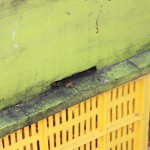Today I put together frames and wired in foundation into beekeeping equipment I got here in Japan. It is for Apis mellifera bees, but I used wax foundation made for Apis cerana bees, which I think is 4.9 mm cell size. The frames are also more closely spaced. I am going to see how the bees do under these conditions.
I have been reading about small cell sized natural beekeeping and regressing bees back down to the size they originally were 100 years ago before there was an effort by the beekeeping industry to make the bees artificially larger by giving them foundation with larger cell size imprinted on it, so I thought I would give it a try and see what happens. I don’t have any personal experience with this yet, so this is my first foray into this area.
My friend, Teruo Shiki, has been keeping Apis mellifera from two swarms that we obtained here in Kyushu. The first was a removal from the wall of a house and the second from a swarm taken off the side of a building this past summer. He made all of his own equipment, both hive boxes and frames, but his frame spacing was not good, so the comb has not been built cleanly. There is burr comb built up because the frames were too far apart. It becomes harder for the bees to cluster and keep the brood warm under those conditions too, so they have not done too well.
It was surprising to see that the commercial beehive I purchased fits perfectly over the top of the hive that he made. One possible problem is that his frames in the bottom box are running the short way, while mine in the upper box run the long way, so they are at right angles to each other. I want to see if the bees will move up into the upper box and use it so then we can eventually get rid of the lower box and will have everything in somewhat standardized equipment.



Prof, I’ve read somewhere on beekeepers forum (couldn’t recall which one) that the regression do work, but take times they say.
I was thinking on experimenting on the Cerana Indica to grow bigger. starting with the queen. graft a day old larvae of the Cerana, put in Q cup cell and let the Mellifera hive tend to it. then if the Q emerge, hopefully it will mate with normal size Cerana drone, lay eggs and then overpopulate the Mellifera in te same hive.
do you think its possible?
the reason of course the honey yield along with resistance to mites.
Hasan,
Thank you for your comment and question. Of course there would be no exchange of genetic material between the cerana and the mellifera, but it is conceivable that your experiment could work. I personally doubt it will work, but what have you got to lose by trying it? If nothing else, you will learn from the result of your experiment. I would be interested to hear what you find out too. I have read that cerana and mellifera can be kept mixed in one hive together and will communicate and cooperate with one another, but if I am not mistaken, the queen was mellifera. Best wishes and good luck to you. The best teacher is experience.